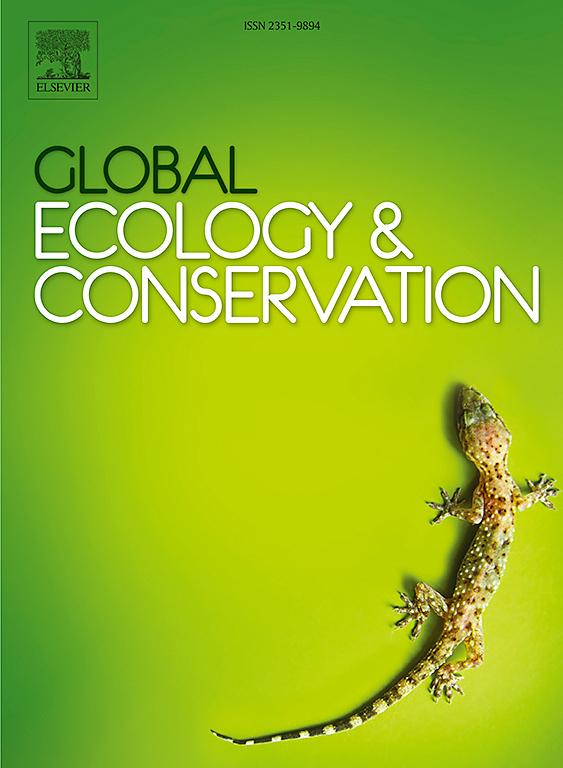坦桑尼亚塞伦盖蒂西部野生动物犯罪和罪犯的人口特征:2012-2022年法庭案件回顾
IF 3.4
2区 环境科学与生态学
Q1 BIODIVERSITY CONSERVATION
引用次数: 0
摘要
野生动物犯罪是对野生动物保护的重大全球威胁,减少了野生动物数量,并威胁到一些物种的灭绝。在坦桑尼亚,环境法当局和政府为打击这些罪行作出了重大努力,逮捕了嫌疑犯,并在全国各地的不同法院提起诉讼。了解法院对野生动物案件的判决可以更广泛地了解如何加强目前的刑事调查和起诉制度。我们回顾了从2012年1月到2022年6月的10年间,由保护法律当局提交并在塞伦盖蒂地区法院(SDC)登记的野生动物案件,以评估野生动物犯罪指控、法院对案件的判决以及被告的基本人口特征。我们发现,大多数案件的结果是监禁定罪或非监禁罚款。平均监禁时间为8年,从非法进入保护区的6个月到拥有象牙和步枪的30年不等。大多数案件发生在6月至10月的旱季,总体趋势显示2014年至2022年案件数量下降。向法院提交的证据表明,角马是最常被偷猎的物种,而铁丝网是最常用的诱捕有蹄类动物的技术。此外,提出的证据和访谈结果表明,偷猎不仅是为了获取丛林肉或经济利益而进行的谋生活动,而且还涉及其他民族动物学方面。评估野生动物案件的下降趋势以及新的政府反偷猎战略和处罚的效果,需要进一步分析来自坦桑尼亚几个不同法院的数据。本文章由计算机程序翻译,如有差异,请以英文原文为准。
Wildlife crimes and the demographic characteristics of offenders in western Serengeti, Tanzania: A review of court cases 2012–2022
Wildlife crimes are significant global threat to conservation, reducing wildlife populations and threatening some species to extinction. In Tanzania, substantial efforts have been made by conservation law authorities and the government to combat these crimes by apprehending suspects and filing cases in various courts throughout the country. Understanding court decisions on wildlife cases filed can provide a broader understanding of how to enhance the current criminal investigations and prosecution system. We reviewed wildlife cases filed by conservation law authorities and registered at Serengeti District Court (SDC) for ten years from January 2012 to June 2022 to assess the wildlife crime charges, the court decisions on the cases filed, and the rudimentary demographic characteristics of the accused. We found that most cases resulted in custodial convictions or noncustodial fines. The average period of incarceration was 8 years, ranging from 6 months for illegal entry into the protected area to 30 years for possession of elephant tusks and rifles. Most court cases were filed during the dry season from June to October, and the general trend indicated a decline in cases filed from 2014 to 2022. Evidence tendered before the court indicated that wildebeest (Connochaetes taurinus) are the most poached species and wire snare entanglement was the most used technique to trap and catch ungulates. Furthermore, the evidence presented and the interview results indicate that poaching was not only a subsistence activity for bushmeat or economic gain, but also involved other ethnozoological aspects. Assessing the declining trend in wildlife cases and the efficacy of the new governmental antipoaching strategies and penalties will require further analysis of data from several different Tanzanian courts.
求助全文
通过发布文献求助,成功后即可免费获取论文全文。
去求助
来源期刊

Global Ecology and Conservation
Agricultural and Biological Sciences-Ecology, Evolution, Behavior and Systematics
CiteScore
8.10
自引率
5.00%
发文量
346
审稿时长
83 days
期刊介绍:
Global Ecology and Conservation is a peer-reviewed, open-access journal covering all sub-disciplines of ecological and conservation science: from theory to practice, from molecules to ecosystems, from regional to global. The fields covered include: organismal, population, community, and ecosystem ecology; physiological, evolutionary, and behavioral ecology; and conservation science.
 求助内容:
求助内容: 应助结果提醒方式:
应助结果提醒方式:


